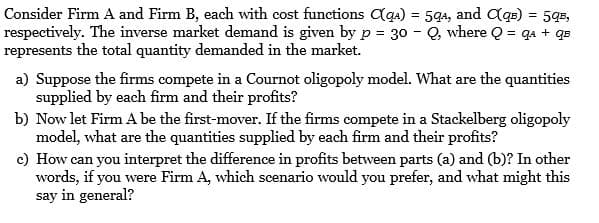Consider Firm A and Firm B, each with cost functions C(qA) = 5qA, and C(qB) = 5qB, The inverse market demand is given by p = 30 − Q, where Q = qA + qB represents the total quantity demanded in the market. a) Suppose the firms compete in a Cournot oligopoly model. What are the quantities supplied by each firm and their profits? b) Now let Firm A be the first-mover. If the firms compete in a Stackelberg oligopoly model, what are the quantities supplied by each firm and their profits? c) How can you interpret the difference in profits between parts (a) and (b)? In other words, if you were Firm A, which scenario would you prefer, and what might this say in general?
Consider Firm A and Firm B, each with cost functions C(qA) = 5qA, and C(qB) = 5qB, The inverse market demand is given by p = 30 − Q, where Q = qA + qB represents the total quantity demanded in the market. a) Suppose the firms compete in a Cournot oligopoly model. What are the quantities supplied by each firm and their profits? b) Now let Firm A be the first-mover. If the firms compete in a Stackelberg oligopoly model, what are the quantities supplied by each firm and their profits? c) How can you interpret the difference in profits between parts (a) and (b)? In other words, if you were Firm A, which scenario would you prefer, and what might this say in general?
Managerial Economics: Applications, Strategies and Tactics (MindTap Course List)
14th Edition
ISBN:9781305506381
Author:James R. McGuigan, R. Charles Moyer, Frederick H.deB. Harris
Publisher:James R. McGuigan, R. Charles Moyer, Frederick H.deB. Harris
Chapter12: Price And Output Determination: Oligopoly
Section: Chapter Questions
Problem 2E
Related questions
Question
Consider Firm A and Firm B, each with cost functions C(qA) = 5qA, and C(qB) = 5qB, The inverse market demand is given by p = 30 − Q, where Q = qA + qB represents the total quantity demanded in the market.
a) Suppose the firms compete in a Cournot oligopoly model. What are the quantities supplied by each firm and their profits?
b) Now let Firm A be the first-mover. If the firms compete in a Stackelberg oligopoly model, what are the quantities supplied by each firm and their profits?
c) How can you interpret the difference in profits between parts (a) and (b)? In other words, if you were Firm A, which scenario would you prefer, and what might this say in general?

Transcribed Image Text:Consider Firm A and Firm B, each with cost functions Cqa) = 59a, and Cqe) = 5q5,
respectively. The inverse market demand is given by p = 30 - Q, where Q = qa + qs
represents the total quantity demanded in the market.
a) Suppose the firms compete in a Cournot oligopoly model. What are the quantities
supplied by each firm and their profits?
b) Now let Firm A be the first-mover. If the firms compete in a Stackelberg oligopoly
model, what are the quantities supplied by each firm and their profits?
c) How can you interpret the difference in profits between parts (a) and (b)? In other
words, if you were Firm A, which scenario would you prefer, and what might this
say in general?
Expert Solution
This question has been solved!
Explore an expertly crafted, step-by-step solution for a thorough understanding of key concepts.
This is a popular solution!
Trending now
This is a popular solution!
Step by step
Solved in 3 steps with 3 images

Knowledge Booster
Learn more about
Need a deep-dive on the concept behind this application? Look no further. Learn more about this topic, economics and related others by exploring similar questions and additional content below.Recommended textbooks for you

Managerial Economics: Applications, Strategies an…
Economics
ISBN:
9781305506381
Author:
James R. McGuigan, R. Charles Moyer, Frederick H.deB. Harris
Publisher:
Cengage Learning



Managerial Economics: Applications, Strategies an…
Economics
ISBN:
9781305506381
Author:
James R. McGuigan, R. Charles Moyer, Frederick H.deB. Harris
Publisher:
Cengage Learning




Exploring Economics
Economics
ISBN:
9781544336329
Author:
Robert L. Sexton
Publisher:
SAGE Publications, Inc
